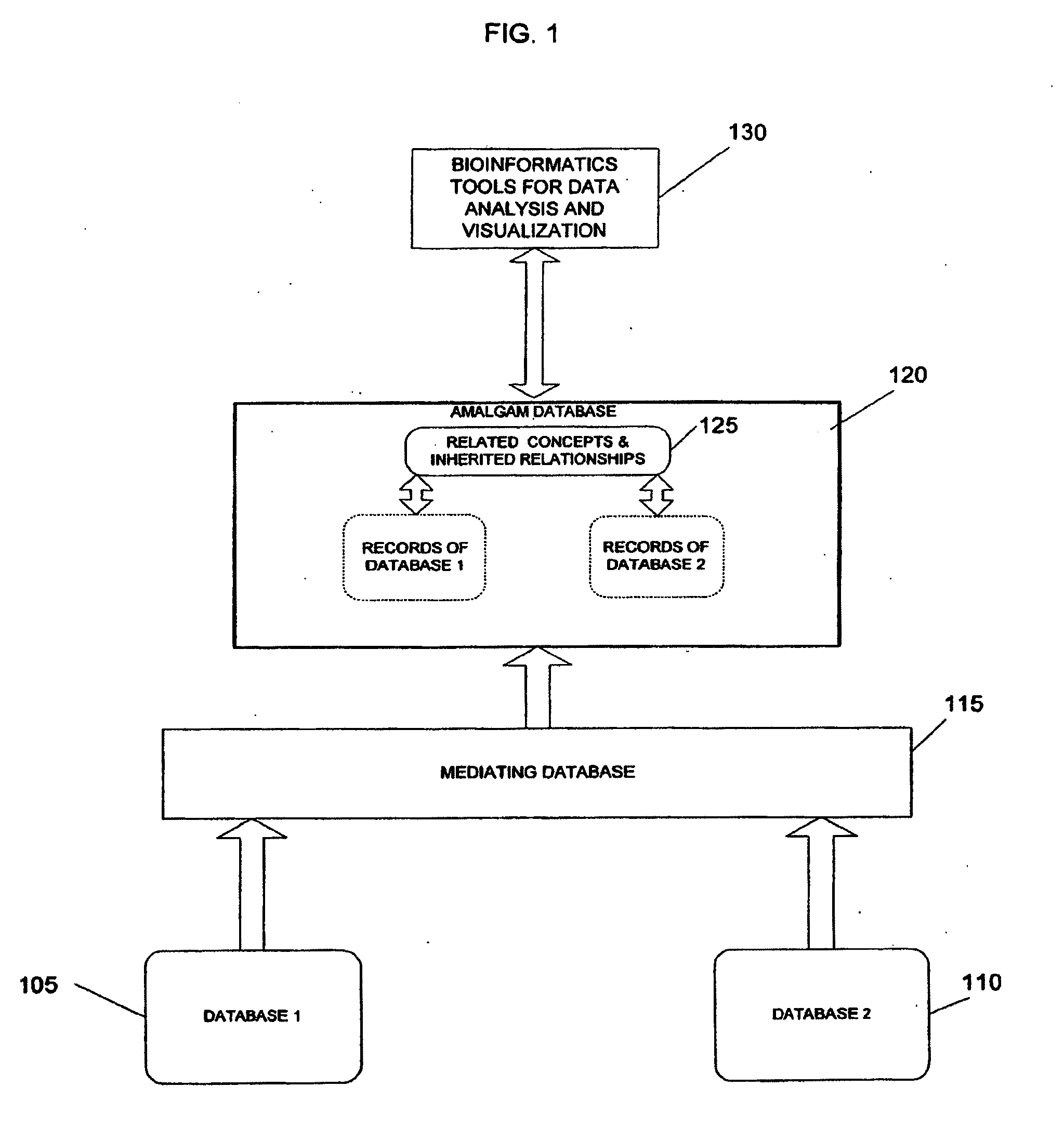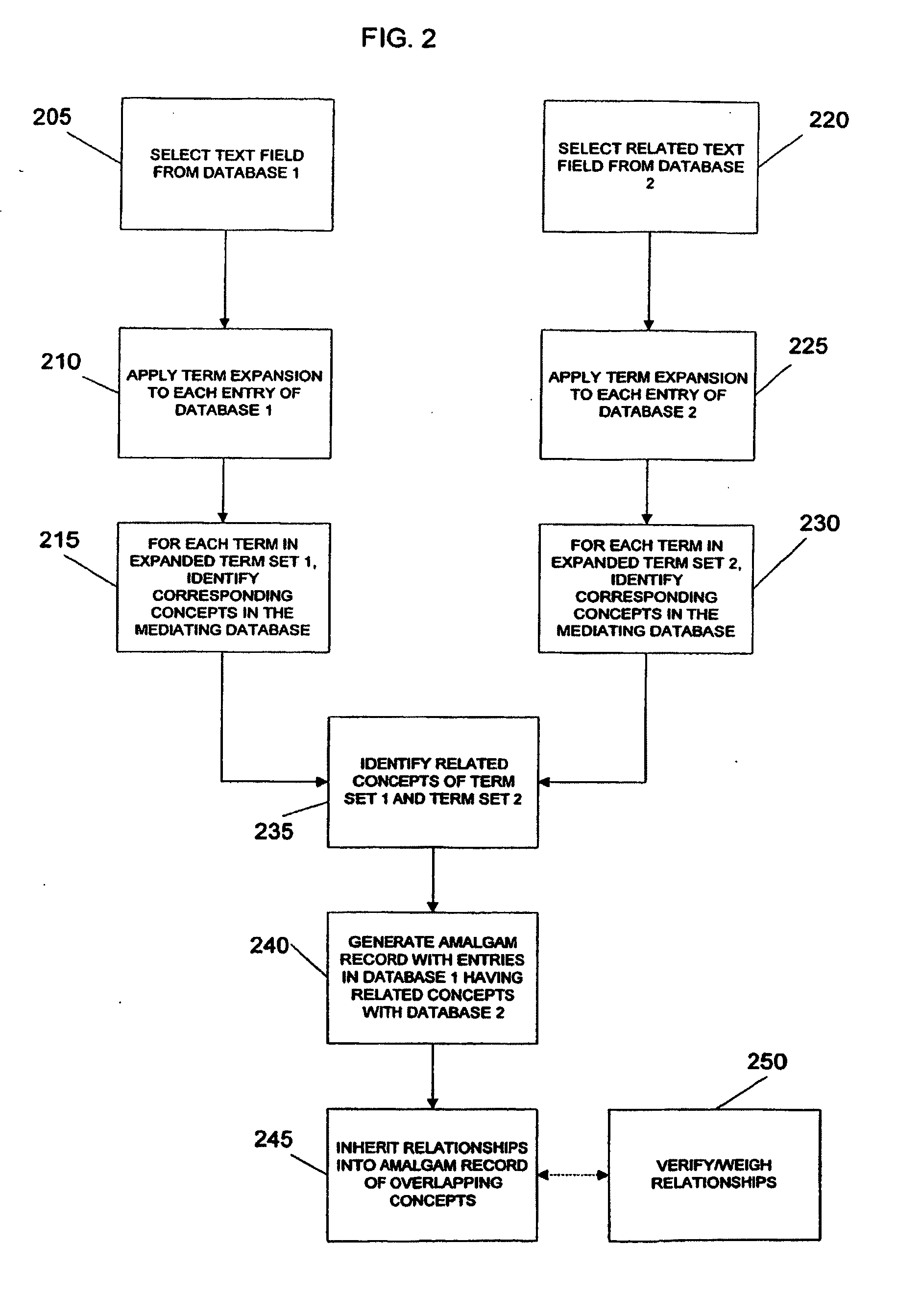System And Method For Generating An Amalgamated Database
a database and database technology, applied in the field of database architecture, can solve the problems of complex data that requires novel methods of analysis, requires more complicated, and requires multi-variate methods of analysis, and achieves the barrier to the integration of heterogeneous phenotypic databases
- Summary
- Abstract
- Description
- Claims
- Application Information
AI Technical Summary
Benefits of technology
Problems solved by technology
Method used
Image
Examples
example 1
Terminological Mapping
[0074]An automated multi-strategy mapping method for high throughput combination and analysis of phenotypic data deriving from heterogeneous databases with high accuracy has been developed. The method includes a mapping strategy that provides for the assessment of the qualitative discrepancies of phenotypic information between a clinical terminology and a phenotypic terminology.
[0075]The method made use of Phenoslim, SNOMED and UMLS. Phenoslim is a particular subset of the phenotype vocabularies developed by Mouse Genome Database (MGD) that is used by the allele and phenotype interface of MGD as a phenotypic query mechanism over the indexed genetic, genomic and biological data of the mouse. The 2003 version of PS containing 100 distinct concepts was used in the current study.
[0076]As noted above, the SNOMED CT terminology (version 2003) is a comprehensive clinical ontology that contains about 344,549 distinct concepts and 913,697 descriptions, which are test st...
example 2
Results for Example 2
[0111]For each disease trace, the putative genes were determined in an average time of ten seconds. Example results are shown as aggregate data, based on types of genes found, in the tables of FIGS. 8A and 8B.
[0112]Traceable Diseases
[0113]Over 200,000 possible disease concepts on which traces could be performed were found, based on the search on UMLS concepts that were descendants of the UMLS concept for “disease” (C0012634). Additionally, 240 OMIM diseases that had corresponding CUIs on which a trace could be performed were identified.
[0114]Quantitative Evaluation
[0115]For the 240 OMIM diseases, 160 were identified with corresponding genes in OMIM's genemap; of these, 48 had traceable gene products. In each trace, additional concepts in MRREL and MRCOC were identified that then corresponded with GO annotations, as per the putative mappings between the terminologies. Of these, GenesTrace was able to perform a successful trace of GO annotated genes for 15 disease...
example 3
Results for Example 3
[0145]Concept-based Quantitative Evaluation. The accuracy of the present terminological mapping using the network are summarized in the graph of precision version recall in FIG. 10. As described in FIG. 9, manual curation utilizes the internal mapping of OMIM and SNOMED 3.5 in UMLS, which simulates the linking of HDG and SNOMED via a common and pre-existing index. This sets the baseline for the performance of paths derived from the network. The present analysis shows that the manually curated pathway provided a better precision (62.7% and 76.2% for CoM and CIM, respectively), and poorer recall (7.1% for CoM, 8.7% for CIM) than the automated mapping. The direct mapping of HDG to SNOMED (P2) provided an intermediate accuracy as compared to other techniques (42.9% for recall and 50% for precision using CoM). Paths involving one level of intermediating terminologies either give higher recall (such as P3 and P4) while sacrificing a degree of precision, or vice versa ...
PUM
 Login to View More
Login to View More Abstract
Description
Claims
Application Information
 Login to View More
Login to View More - R&D
- Intellectual Property
- Life Sciences
- Materials
- Tech Scout
- Unparalleled Data Quality
- Higher Quality Content
- 60% Fewer Hallucinations
Browse by: Latest US Patents, China's latest patents, Technical Efficacy Thesaurus, Application Domain, Technology Topic, Popular Technical Reports.
© 2025 PatSnap. All rights reserved.Legal|Privacy policy|Modern Slavery Act Transparency Statement|Sitemap|About US| Contact US: help@patsnap.com



